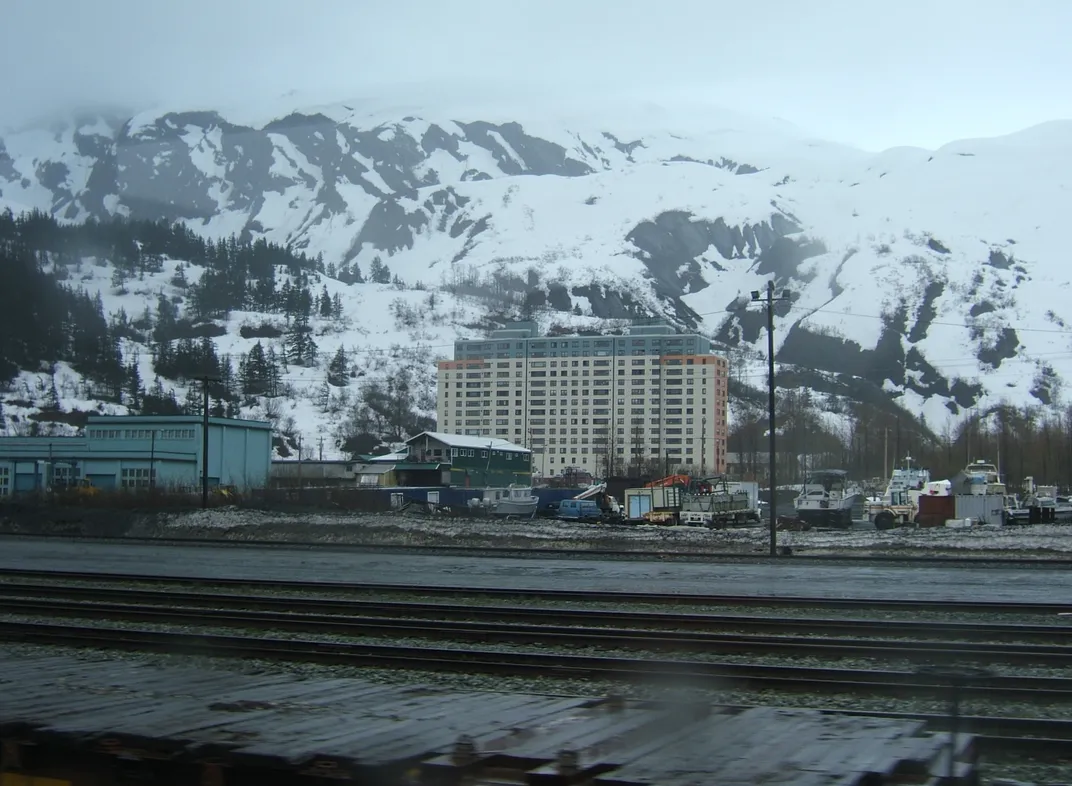In This Alaskan Town, Every Resident Lives in the Same Building
Winter in Whittier means one thing: a self-contained city in Begich Towers
/https://tf-cmsv2-smithsonianmag-media.s3.amazonaws.com/filer/7e/a2/7ea260b8-ca79-4500-a8be-1b5f972de47d/whittier_harbour_ak.jpg)
During the 22 hours of sunlight that bathe Whittier, Alaska each day in the summertime, the town at the mouth of Prince William Sound plays host to cruise ships and outdoor tours that bring in more than 700,000 visitors annually. The tourists stop in at the few small shops in town; spend their downtime hunting, fishing, hiking, and sightseeing; then leave for other Alaskan adventures.
But come wintertime—a season characterized as "wet and wild" by one observer—the village empties out. Whittier is a seasonal town, accessible by boat in the summer or on land year-round via a single two-and-a-half-mile tunnel under Maynard Mountain. That tunnel works on a rotational basis, running one direction only, switching every half hour, and closing for the night at about 11 p.m. If you aren't in line for the final trip through the tunnel, you're stuck on one side until it opens again in the morning. When all the tourists leave Whittier, only about 218 residents are left—and almost all of them live in one building, Begich Towers. They don't just live there in the bitter winter, though. Most have condos for the entire year, but spend much of the summertime out running businesses and helping tourists.

Begich acts as its own self-contained city throughout the winter, providing residents everything they need to survive the harsh season. The building (which is currently undergoing renovations) is about 70 years old, and was originally used as housing for military families and bachelor officers during World War II. The tower is actually three structures mashed into one: an east building, a middle building, and a west building, combined over four years from 1953 to 1957.
Now, though, Begich is much more than a building. When the town mostly closes down for the winter, residents return to full-time occupation in their condos, stopping at various floors in the building to meet all their needs. There’s a playground, a church, a post office, a clinic, two convenience stores, a police station, a video rental store, city offices and a laundromat all under the one roof. The school (where the only gym is located) is across the street, accessible via an underground tunnel.
June Miller, a year-round Whittier resident who lives in the tower and runs a vacation rental business on the tower's top two floors—June’s Whittier Condo Suites—says that coming back to the tower in the wintertime is an exercise in reconnection. “It’s like a low-scale reunion,” she tells Smithsonian.com. “You hear, ‘Oh hi, I haven’t seen you for a while, you’ve been busy!’ ‘Oh yeah, I’ve been running around taking care of tourists.’”
Winter at Begich is a low-key affair, says Miller: Residents get together and play cards, entertain one another and go to town in groups to shop for what they can’t find at the on-site convenience store. And although everyone generally gets along and coexists in a quiet harmony, some people do have bad days. In this enclosed space, though, residents are more understanding and willing to give someone their personal space as needed. “If somebody’s crabby around here, we just tell them, ‘Alright I’ll see you later,’” Miller says. “Let them go and take care of their issues.” After some time apart, she says, everything gets back to normal.
Activity in the sleepy tower picks up when heavy snow falls, reaching 16 feet or more and drawing skiers and other winter sports enthusiasts to Whittier, while northern lights hunters head farther north to Fairbanks. Those visitors either stay in the tower or in sparse lodging options outside the building. But Miller is quick to point out that only those with a sense of spontaneity are likely to visit in the winter. “Because [Begich is] historical, some people don’t know if they want to be in the building,” she says. Guests worry about the age of the building and wonder about the rooms. And while lodging isn't exactly luxury, it's still comfortable with picturesque views and warm enough to keep you cozy in the cold season. But that's not enough to sway every visitor. “They don’t even like the tunnel,” Miller says. “It’s not for the weak and the squeamish, but it’s for the adventurous, happy and ready-for-anything type people.”
Planning Your Next Trip?
Explore great travel deals
Smithsonian magazine participates in affiliate link advertising programs. If you purchase an item through these links, we receive a commission.
/https://tf-cmsv2-smithsonianmag-media.s3.amazonaws.com/accounts/headshot/JenniferBillock.png)
/https://tf-cmsv2-smithsonianmag-media.s3.amazonaws.com/accounts/headshot/JenniferBillock.png)